Zanskar has remained one of India’s most mysterious regions for a long time. During peak winters the Zanskar region in Ladakh freezes solid making it seem like a Chadar (a carpet of ice). The beautifully frozen sheet of ice has invited travelers and trekkers from all across the world over the past many years making Chadar Frozen River Trek one of India’s most famous & grueling and enthralling treks (If you’re looking at trekking to Chadar, don’t forget to check out our itinerary). The temperatures in the region during the trek can plummet to sub-zero degrees and you will need to take extra care of ensuring that you’re physically fit and well prepared to take the negative temperatures.
All You Need to Know About Chadar Trek

To help you equip yourself for the trek in the best possible manner, here’s your A – Z guide on the Chadar trek. From the right exercises to ensure physical fitness to packing right and more practical tips on prepping for your trek, this guide has everything.
The Best Season to Trek to Chadar
The Zanskar river completely freezes in early January and remains frozen for a good two months from then. The best time to do the Chadar trek is from mid of January to early February. It is important to ensure that you keep getting regular updates on the weather conditions in the region.
Who Can Trek to Chadar?
Chadar is called India’s most difficult trek for a reason. From trekking in temperatures that go below -30°C to camping in the trail without basic comforts, covering over 10 Km every day in challenging environments, and risking the dangers of walking over ice, Chadar requires not only a good level of physical fitness but also a great level of mental preparation.
Trekkers with a good level of fitness and who’ve done Himalayan treks before can take up the Chadar trek.
Fitness Level Required for the Chadar Trek
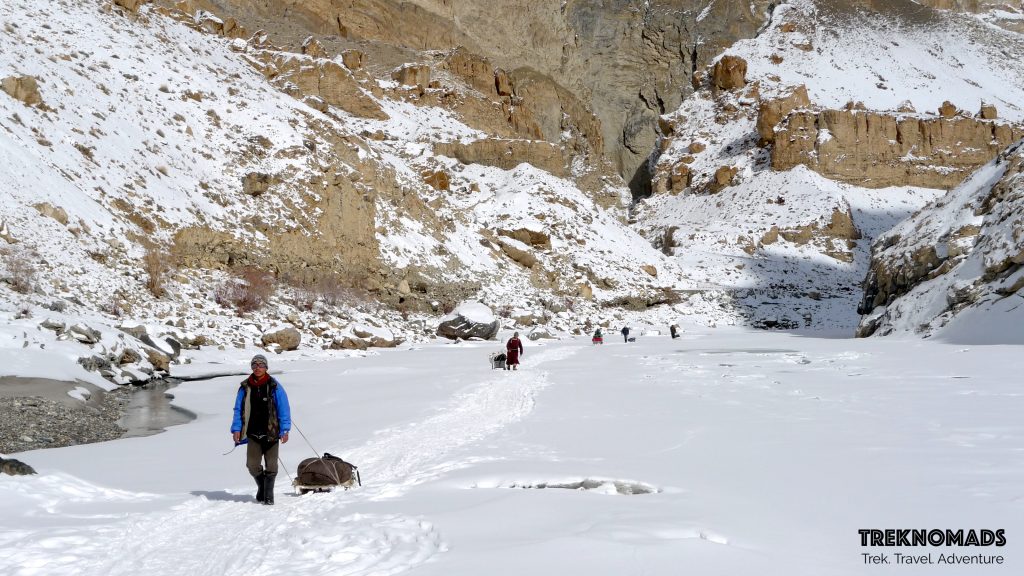
Chadar is known to test your mental strength, the trek definitely puts mind over matter. Imagine this – The trek does not involve any kind of ascents and descents like other Himalayan treks. You will be walking on a frozen river for about 5-6 hours every day for 5 days. You will be required to carry a backpack of about 10 kgs.
A moderate level of fitness is quite good to complete the Chadar Trek with ease.
Getting Fit for the Frozen River Trek
The first thing you will need to do is evaluate your current fitness level. Once you do this you will have a good idea of the amount of effort you need to put in to get fit for the trek.
To prepare for the Chadar trek, you will need to ensure that you work out not only your body but your mind as well. Here’s a quick 8-week regime of curated exercises that we’ve built to help you reach the best fitness level for Chadar trek:
- Stair Climbing
Days: Mon, Thurs
Routine: 5 min – (2.5 min continuously*2 sets) with a 1 min break between each set
How will this help – Pushing your body against gravity is a great cardiovascular activity. Stair climbing helps strengthen the muscles around your knees and helps build endurance. - Push-Ups
Days: Mon, Thurs
Routine: 5*2 Set (10) – (1 min rest between each set)
How will this help – Push-ups help you build a stronger upper body while strengthening your core. This exercise helps when you have to ascend while carrying a backpack. - Squats
Days: Mon, Thurs
Routine: 5*2 Set (10) – (1 min rest between each set)
How will this help – Squats are the best form of functional fitness. They promote balance and stability and strengthen legs, thighs, hips, buttocks, and hamstrings. - Crunches
Days: Tues, Fri
Routine: 5*2 Set (10) – (1 min rest between each set)
How will this help – Crunches work on your abdominal muscles to build your core strength. This exercise will help you keep your balance on uneven surfaces. - Interval Running
Days: Tues, Fri
Routine: 15 min – (alternate 60 secs of continuous running 90 secs brisk walk)How will this help –Running is a great cardiovascular workout, it is also an aerobic activity that uses more oxygen. This workout helps makes your lungs stronger.
- Burpees
Days: Tues, Fri
Routine: 5*2 Set (10)- (1 min rest between each set)
How will this help – Burpees is a great full-body strength training exercise and the ultimate example of functional fitness which helps abs, hamstrings, chest, glutes, and arms. - Rest
Days: Wed, Sat, Sun
How will this help – Rest is an integral part of your fitness routine which must not be missed. Overdoing can cause an unnecessary injury to your body.
You can also be a part of a monitored fitness regime run by our Trek Captain – Naveen Mallesh.
Checklist to Pack Right for your Chadar Trek:
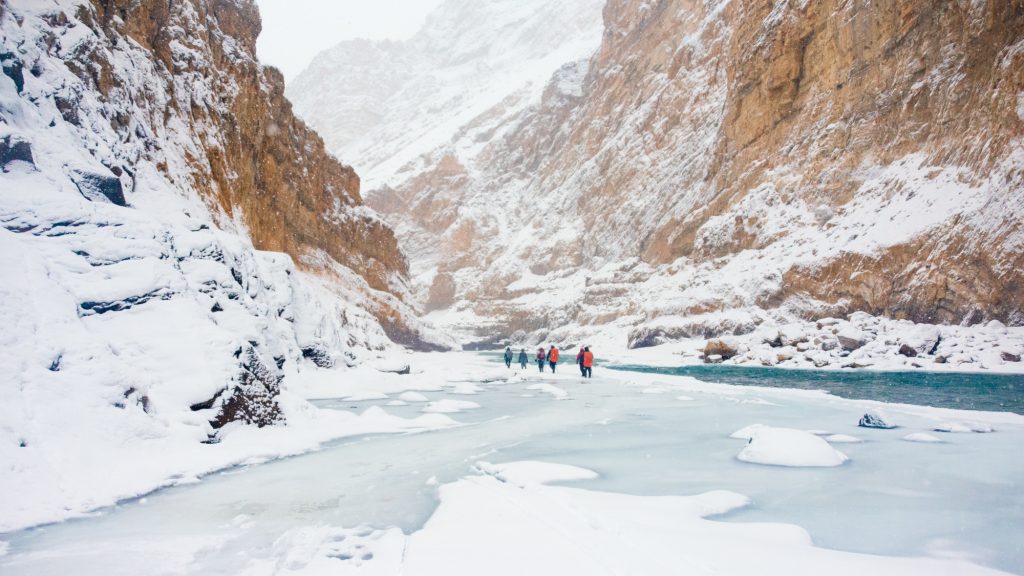
Gear:
- Rucksack: 60 – 70 liters to carry all your gear. This bag will be carried by porters. Ensure that you pack only the necessary items and avoid overpacking.
- Backpack: A 20-25 liters backpack that you will carry on your trek every day. This backpack will have water bottles, lip balm, moisturizing lotion, camera, power bank, energy/protein bars, sunglasses, hand towel, extra pair of active/dri-fit/synthetic socks – all of this is good enough to get you through the trek easily. Also, get a cover for your backpack.
Footwear:
Your boots are probably one of the most important equipment you will be required to wear on your Chadar trek – we would definitely recommend you invest well in a good pair of shoes.
You will need to make sure that your boots are high-ankled, waterproof and well insulated to help you protect from the freezing temperature. Decathlon has a great pair of waterproof shoes for men & for women.
Alternatively, don’t forget to carry a pair of open sandals that can be worn at the campsite. It is essential that you give your feet some relief from the boots after trekking for long hours. Make sure that you wear these with a good pair of woolen socks.
Occasionally, you may also come across instances where you will have to walk through a small level of freezing water, we know how scary this may sound. But this is where your gumboots will come into the picture. Wearing gumboots during the trek is a mandate. You can either buy the boots online or easily buy them once you land in Leh. The starting price for a good pair of gumboots is INR 350 (This is a more recommended option as you will save up on your rucksack space).
Socks:
We know that the first option that comes to mind when it comes to choosing the right socks in this instance is Woolen. But let us tell you, trekking in woolen socks can be a bit of a pain. The best choice of socks you can carry is the ones meant for active-wear. These normally come with a blend of woolen and synthetic fabric. Not only do they dry faster, they make your feet comfortable – something that is essential for long-distance hiking.
It is also recommended that you keep an extra pair of socks for each day in case your current socks get wet, you will need to change your socks without any delay.
Carry about 4 pairs of active-socks and 4 pairs of Woolen socks. Once you reach your camp for the day, ensure that you clean & dry your feet and wear the woolen socks (2 pairs to make it extra warm as temperatures would dip down in the night).
Gloves:
A Chadar trek guide would be incomplete without a great pair of gloves. You will be wearing gloves all through the day. You are required to carry about 4 pairs of good woolen gloves.
Clothing & Accessories:
This where you will have to be smart. When it comes to the Chadar trek the trick is to not just layer up, but layer up right.
Here’s a quick guide to layering up for any snow trek:
Head Gear:
- Woolen Cap – That can cover your ears and head entirely
- Woolen balaclava that can cover your neck, mouth and nose
- Polaroid sunglasses – with UV protection
- Headlamp – in case it gets dark while trekking
- Sun cap with a back flap to protect your nape
Layering your Upper Body while at camp:
-
- Thermals – Layer 1
- T-Shirt (Dri-Fit – preferably to absorb sweat) – Layer 2
- Sweater – Layer 3
- Another layer of sweater – Layer 4
- Fleece jacket – Layer 5
- Down Jacket or polyfill padded jacket – Layer 6
- Gloves
Layering your Upper Body while trekking:
-
- Thermals – Layer 1
- T-Shirt (Dri-Fit – preferably to absorb sweat) – Layer 2
- Fleece jacket – Layer 3
- Down Jacket or polyfill padded jacket – Layer 4
- Gloves
Layering up your Lower Body while at Camp:
- Basic thermals
- Trekking trouser
- Polyester trekking socks
- Woolen socks
Layering up your Lower body while trekking:
- Trekking trousers
- Polyester or active-wear socks
- Trekking shoes
Pro-Tips:
- If you wear spectacles, you can either wear it below a pair of oversized sunglasses. You could also get powered polaroid glasses made. Brands like Lenskart, Titan, etc. can custom make powered sunglasses for you.
- For those of you who wear contact lenses, you can keep using them on the trek without any worry. Just make sure you carry enough cleaning solution so you clean your fingers well before wearing the lens.
- Avoid carrying knitted jackets on the trek. Not only are they heavy, but they also don’t protect you enough from snowfall.
- For your base T-Shirt, avoid carrying cotton T-Shirts and opt for Dri-Fit T-Shirts instead. These will absorb your sweat and keep you dry at all times.
- If you are planning on buying a jacket, opt for a padded jacket instead or a down jacket. Padded jackets are low maintenance and are generally water-resistant.
- When you buy pants, make sure you buy the ones with the zipper pockets. These will help you keep your phones safe and handy.
- Don’t substitute track pants for your trek pants. Track pants can be worn as an extra layer in case you’re feeling too cold, but definitely avoid wearing them as your trek pants.
- Avoid anything cotton on this trek. The region you’re trekking to won’t let you dry clothes and accessories very easily. From hand towels to T-shirts, and pants, avoid cotton.
Other Accessories:
- Water Bottles – (One Thermas & one regular bottle – 2*1 Litres)
- Toiletries, wet wipes & tissue rolls (2)
- Sunscreen – SPF 40 & above
- Moisturizing lotion, lip balm, and Deo stick/deodorant
- Personal medicines (The trek lead will be carrying a basic first aid kit)
- Utility kit – Safety pins, rubber bands, clips, needles etc.
- Plastic bags – biodegradable
- Power bank – 2 preferably
- 5 Photocopies of your PAN/AADHAR/PASSPORT for various permits etc.
- Passport Size photos – 3 – 4
**If you need any help in picking out the right clothing, gear, and accessories for the trek, our trek experts can help you with that.
Permits & Regulations for the Chadar Trek
To ensure that trekkers are safe and abide by the rules, the Leh Government has brought in a few regulations & permits that you will need to follow & get upon arrival in Leh.
As a standard procedure, trekkers must:
- Acclimatize in Leh for two days post-arrival & before departing for the trek
- Go through a medical check-up and get a medical certificate from a local medical board in Leh that states that you have acclimated to the altitude and are physically fit to take on the trek
- Mandatorily have trek & personal accident insurance for the trek
- Get a permit from ALTOA post submission of NOC & medical certificate
**The fee for the permit & insurance is usually borne by the participant and is not included in the trek price.
Hydration During the Trek
It’s not uncommon to get dehydrated on treks, it is one of the key factors that can make or break your trek.
Water is one of the most crucial elements that make your body, in fact, 50% – 60% of human body composition is made up of water. It is also just as important to drink plenty of water while trekking. It helps body energized and mind alert during the trek.
Tips to staying hydrated during the Frozen River Trek:
- Your daily consumption of water on days when you are trekking should be between 6-7 liters every day. With 2-3 liters consumed during the trek
- Start drinking the same amount of water at least a week prior to the trek. This is will help your body adapt to the increase in water intake.
- It is important that you substitute for the nutrients and minerals that your body has lost while you sweat. Hydrants such as FAST & UP work towards making up for these lost electrolytes, nutrients and minerals and equip your body for superior performance.
- Keep sipping water every 10 – 15 minutes while on a trek. Especially in a dry and cold region like the Zanskar where you don’t perspire and the chances of dehydration are very high.
Photography Tips for Chadar Trek
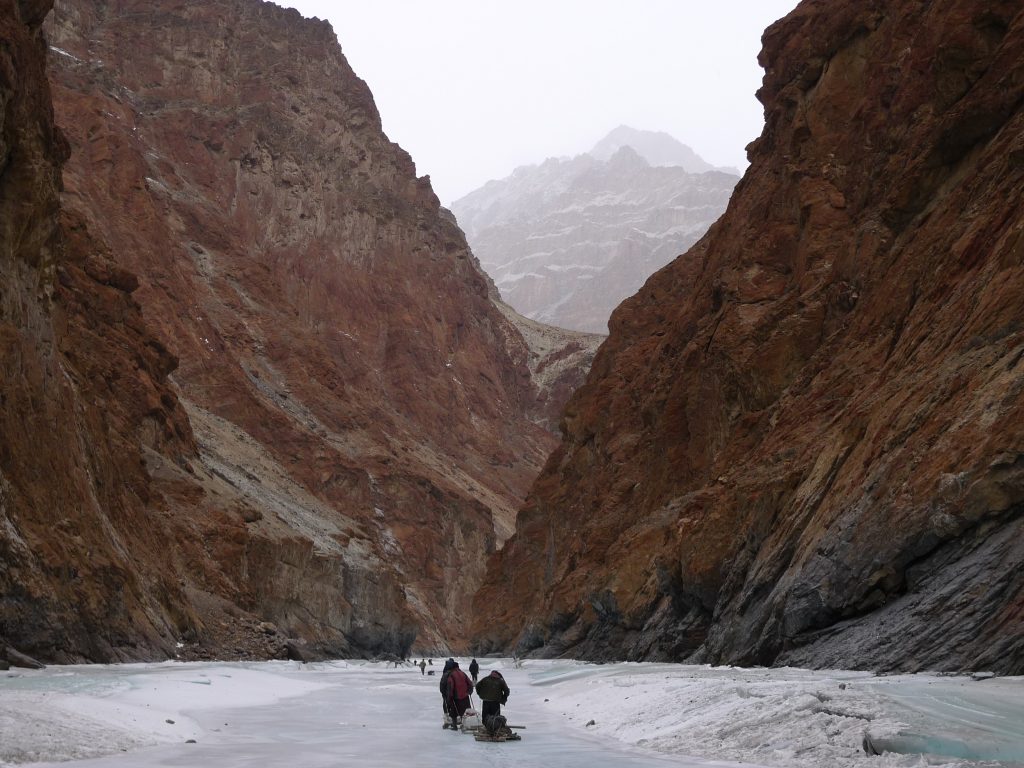
It goes without saying that you would want to capture some unforgettable & Instagram worthy photographs on your trek to Chadar, here are some tips that can help you capture great shots and keep your camera safe.
- If you’re using a camera, ensure that you use it with at least one layer of protection (thin gloves). Metal is a superconductor and this will ensure that you don’t get frostbite. Keep your phone and your camera in an inner pocket or in your pant pocket so that it remains closer to your body temperature.
- If you’re getting a bigger camera bag, make sure that you carry a weather-resistant camera bag.
- Just like you, your camera needs to acclimate as well. Make sure your camera stays for at least 15 minutes in the weather you’re going to shoot in. This will help you avoid excess moisture that builds up in the lens.
- Keep your batteries close to your body heat (cover it up with a sweater in your bag, this will help it sustain in the cold).
- Shoot your photos in manual mode. This will avoid the overexposure of white balance, which you are likely to face in this region.
- Know all about focus and shutter speed in case you wish to capture snowfall shots (depends on the weather conditions)
Chadar Trek – Do’s
- Follow your Trek Captain under any circumstance, he/she knows the best.
- Keep a good stock of protein/energy bars & water during the trek. The route is entirely uninhabited and you won’t find food until you reach Leh.
- Consult your general physician before the trek and carry your personal medicine kit.
- If you’re planning to visit a shrine/stupa, ensure that you dress moderately and pay your respects when you enter these shrines.
- Buy trek insurance to ensure that you are protected at every step along the way.
- Keep your loved ones informed and ensure that you share the details of your emergency contact with your trek captain to ensure that they are well informed of your well being during the trek.
Chadar Trek – Don’ts
- Avoid carrying jeans for the entire trip. You won’t be able to wear it even in Leh
- To avoid littering, we strongly recommend against carrying plastic water bottles and instead
- Avoid carrying single-use plastic of any kind, this will ensure that you do not litter during the trek
- Don’t skip your meals during the trek. This trek is demanding and you will need all the energy you can possibly get for the trek
- Do not bathe or even wash hands with soaps or any kind of chemicals. Remember that this water goes directly to the locals who consume this in their day-to-day life. Do not contaminate it.
- If you’re visiting religious shrine or stupa in Leh, pay your due respects and respect the sentiments of the locals. Do not touch the idol or do anything to hurt their sentiment.
- DO NOT LITTER. Chadar is one of the most beautiful & protected trails in the world. Remember that it is one of it’s kind and as a rule do not litter.
Additional Information about the Chadar Frozen River Trek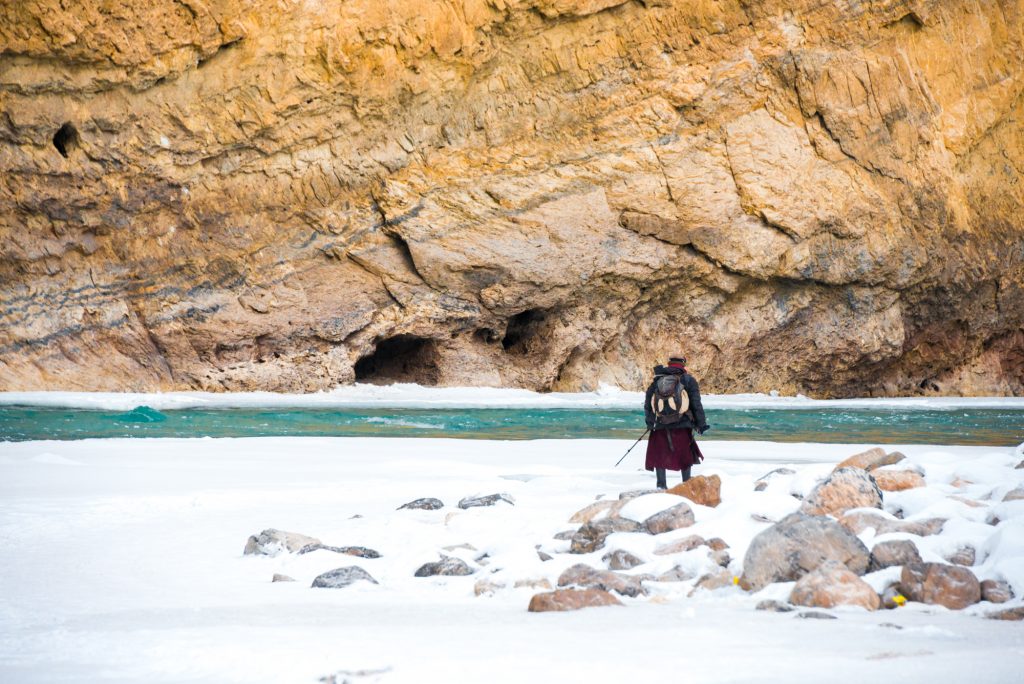
Altitude Map:
- Leh: 11,400 ft (3,500 m)
- Tsomo Paldar: 10,400 ft (3,200 m)
- Tibb Cave: 10,800 ft (3,300 m)
- Nerak: 11,100 ft (3,400 m)
Other Details:
- Trek Gradient: Difficult
- Trek Distance: 60+ Km
- Assembling Point: Leh
- Trek Duration: 25+ hours
- Average Temperature: -5°C to -15°C
Chadar is definitely one of the most grandeur treks in the entire world and requires a good deal of preparation. If you do decide to take up the Frozen River Trek, make sure you use this guide and we promise that you’ll be all set.
Wish to book the trek? Click here.
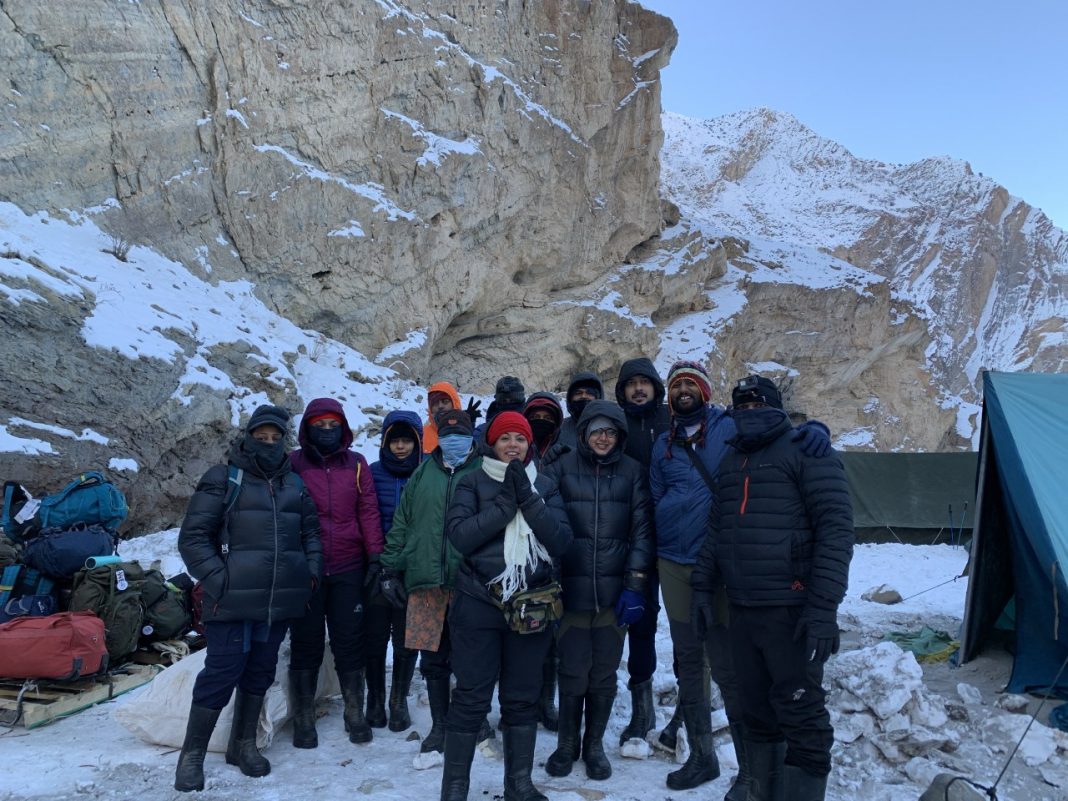
Chadar Frozen River Trek is an isolated, land-locked, remote and beautiful high altitude trek that will gift you an exhilirating experience. I must say, if you will visit here, you will know the different meaning of heaven.
Lot of good material here keep up the good work
Now im so in love with this url , it aids me so much with foregathering excellent info about how to look after myself.